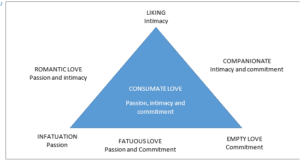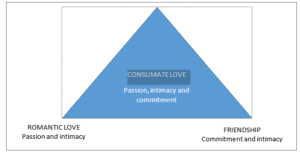Understanding Love, Commitment, and Intimacy
Love is the deeper liking that someone has for another. I believe that this liking can come in different levels. For instance, a romantic liking can be considered as a romantic love. In this kind of love, people can become emotionally and physically intimate. In this love, the physical intimacy is very primary. Then, there are other levels of liking, like the love between brothers and sisters, which may be intimate but are not characterized by physical intimacy (Wong & Mayer, 2023). There is also love that can happen between friends. In this case, both physical and emotional intimacy may not be there. On the other hand, commitment is the decision to be fully dedicated to a relationship so that one remains faithful and upholds the rules that come with that relationship. This can happen mainly in a romantic love relationship (Wong & Mayer, 2023). When one is committed, they remain faithful and willing to abide by the laws that surround the relationship. Intimacy is a deeper connection between two people who love each other. The connection can be physical, which is then portrayed by the decision to engage in sex. The connection can also be emotional; in this case, both partners decide to share all their feelings, emotions, and thoughts without fear of being judged (Yarber & Sayad, 2018). All three of these must be there in romantic love, but only some are needed in the other types of love.
The Sternberg’s Triangular Theory Of Love
This theory by Sternberg explains love and how it is applied in different interpersonal relationships. In this theory, Robert Sternberg explains different types of love using intimacy, passion, and commitment as the scales. In this theory, the psychologist believes that a relationship that lasts is based on more than one element (Sternberg, 1986). This theory also clarifies that different types of love have a different combination of these elements and that age can influence the emphasis one gives to these elements. Through this theory, the psychologist argues that there are seven different ways in which these elements are demonstrated in a relationship. These seven ways also represent the different types of love (Sternberg, 1986). They include liking, which is a general friendship, infatuated love, empty love, romantic love, compassionate love, fatuous love, and consummate love. This theory thus explains that these three elements, passion, intimacy, and commitment, exist in these love relationships even though they exist differently, and they are not all present in one relationship except in consummate love. This is the only type of love that has all three elements together.
The Eight Basic Ways in Which Intimacy, Passion, and Commitment Combine
These three can combine in the first way, called liking. In the case of liking, only intimacy exists. Liking can also be described as friendship. According to this theory, this type of liking is one where an individual may have a strong bond with another. They feel the warmth and closeness with that other person, but they do not have passionate feelings or commitment towards each other. The second connection between these three elements is through infatuated love (Sternberg, 1986). This is a love that only has passion as the element. In this second combination, one may feel a strong feeling of love towards someone, and this is mostly “love at first sight.” With this, the individual only desires sexual connection. In this case, intimacy and commitment are missing. The third way is through empty love. In this case, there is only commitment, yet intimacy and passion are lost. This often happens when consummate love deteriorates. In this case, one feels committed to their partner, but they no longer have intimacy or even passion or sexual desire towards each other. The fourth way is through romantic love. In this case, passion and intimacy exist in this relationship. This is the kind of relationship that exists between lovers where one feels sexual attraction to their partners, and at the same time, they also share their emotions and thoughts. The fifth combination is where there is intimacy and commitment, but passion is lacking. This is what is considered to be companionate love, where one may not have the sexual desire for their partner, but they still share intimacy and feel committed to the relationship. This state can also happen when consummate love deteriorates. The sixth combination is where passion and commitment exist, but intimacy is missing. According to Sternberg (1986), this kind of relationship can happen when people get into a marriage where passion leads to commitment, but intimacy is missing. This combination is called fatuous love. The seventh combination is limerence, which can be similar to infatuation even though there are instances where it can only be characterized by intimacy alone. Only in this combination, does the individual never receive reciprocation. The eighth combination is the combination that everyone desires to have, and this is consummate love. In this case, all three elements exist: passion, intimacy, and commitment.
The Geometry of Love and its Validity
The above triangle shows how the different types of love are manifested based on the three elements identified by Sternberg. They demonstrate that, despite the idea that commitment and intimacy are exclusive to romantic and companionate relationships, there can be closeness in a relationship known as liking. Consistently, infatuation has only passion in it, while empty love has only commitment in it. On the other hand, fatuous love has passion and commitment, while consummate love has all three, and it is the most difficult love to achieve. The triangle of love is valid because these different types of love exist. The only question that may arise is the existence of intimacy where there is no passion. According to van Lankveld et al. (2018), emotional intimacy increases sexual relations among men and women even though it happens more to men than women. Therefore, when this idea is used to evaluate the geometry by Sternberg above, then companionate love and liking may not be valid.
Comparing Sternberg’s Triangle with my own triangle
My own description of love is that it comes in three forms: friendship, romantic love, and consummate love. I believe commitment must exist in others except for romantic love. As such, I believe that some of the love relationships identified by Sternberg can be combined into these three. Hence, my triangle would be demonstrated as follows:
The one similarity that the two geometries have is consummate love. I believe that it is what everyone works towards, which is why it is at the center of the triangle. In this second triangle, friendship, which stands for liking, has commitment and intimacy, but Sternberg’s has commitment alone. I believe that commitment must exist in every relationship, but it can be excluded from romantic love since it can have only passion and physical intimacy (Wong & Mayer, 2023). In this triangle, infatuation also falls under a romantic relationship. One of the notable things is that intimacy is different (van Lankveld et al.,2018). There is physical, emotional, and personal intimacy. Physical intimacy is where one is willing to share their body with the other partner (Yarber & Sayad, 2018). Emotional intimacy is when one is willing to share feelings with the other partner. However, personal intimacy is where one shares only their secrets and thoughts but may reserve their feelings. I was once in a relationship where the only thing that held us together was passion and hanging out together. However, as soon as my partner left for higher education in another State, the relationship ended. Therefore, I believe that Sternberg’s theory is more valid.
References
Sternberg, R. J. (1986). A Triangular Theory of Love. Psychological Review,93(2), 119-135.
van Lankveld, J., Jacobs, N., Thewissen, V., Dewitte, M., & Verboon, P. (2018). The associations of intimacy and sexuality in daily life: Temporal dynamics and gender effects within romantic relationships. Journal of social and personal relationships, 35(4), 557–576. https://doi.org/10.1177/0265407517743076
Wong, P. T. P., & Mayer, C. H. (2023). The meaning of love and its bittersweet nature. International review of psychiatry (Abingdon, England), 35(1), 33–41. https://doi.org/10.1080/09540261.2023.2173001
Yarber, W., & Sayad, B. (2018). Human Sexuality: Diversity in Contemporary Society. United States: McGraw-Hill Education.
ORDER A PLAGIARISM-FREE PAPER HERE
We’ll write everything from scratch
Question
Instructions
Theories on Love
One’s interpretation and understanding of sexuality generally vacillate during his or her lifespan. These experiences are affected by diverse factors that include biopsychosocial, economic, cultural, religious, and spiritual factors. Various theories have come into play and have helped in understanding the concepts of love, intimacy, and commitment.

Understanding Love, Commitment, and Intimacy
Using the South University Online Library, the Internet, or the course readings, research the concept of love, intimacy, and commitment. Based on your research, complete the following tasks:
Provide your understanding of love, commitment, and intimacy.
Describe Sternberg’s Triangular Theory of Love.
Describe the eight basic ways in which intimacy, passion, and commitment combine.
Describe the geometry of love. Assess the validity that you think these above-mentioned theories hold.
Explain the different types of love. Sit with your partner, examine Sternberg’s triangle and chalk out your own triangle. Ask your partner to do the same. Now, analyze thoroughly and look how they match or did not match. Compare the balance of your relationship with the readings provided in the textbook (if you are not in a relationship currently, you may use a previous relationship).



